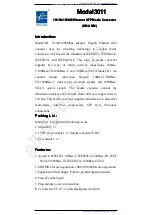
Page 18 Non-Sound Decoder MX618 - MX638 and Sound Decoder MX640 - MX659
CV
Denomination
Range
Default
Description
#6
Medium Speed
Vmid
1,
¼ to ½
of the val-
ue in
CV #5
1
(= @ 1/3 of top
speed)
Internal spee
d step (1 … 255) applied as
medium
external speed step (that is, speed step
7, 14 or 64 depending on the speed step mode se-
lected in CV #29, Bit 1)
”1" = default (Medium speed is set to one third of top
speed. I.e., if CV #5 = 255 the curve is the same as if
CV #6 would be programmed to 85).
The speed curve resulting from CV #2, 5 and 6 is au-
tomatically smoothed out.
#29
Basic
configuration
0 - 63
14 =
0000 1110
with Bit 4 = 0
(3-speed step)
Bit 0 - Train direction:
0 = normal, 1 = reversed
Bit 1 - Number of speed steps:
0 = 14, 1 = 28/128
Bit 2 - DC operation (analog): *)
0 = disabled 1 = enabled
Bit 3 -
RailCom („bidirectional communication“)
0 = deactivated 1 = activated
Bit 4 - Individual speed table:
0 = off, CV # 2, 5 and 6 are active.
1 = on, according to CV ‘s # 67 – 94
Bit 5 - Decoder address: 0 = primary address
as per CV #1 1 = ext. address as per CV
#17+18
#67
.…..
#94
Individual speed table,
if CV #29, Bit 4 = 1
0 - 255
*)
User programmable speed table.
Each CV corresponds to one of the 28 external speed
steps that can be “mapped” to internal steps (1 –
255).
*) The 28-point default curve is also bent in the lower
speed range.
#66
#95
Directional
speed trimming
0 - 255
0 - 255
0
0
Speed step multiplication by “n/128”
(n is the trim value in this CV)
#66: for forward direction
#95: for reverse direction
The reference voltage for motor regulation
CV # 57
specifies the base voltage used for motor regulation. For example: if 14V is selected (CV
value: 140) the decoder tries to send the exact fraction of this voltage, determined by the speed regu-
lator position, to the motor, regardless of the voltage level at the track. As a result the speed remains
constant even if the track voltage fluctuates, provided the track voltage (more precisely, the rectified
and processed voltage inside the decoder, which is about 2V lo
wer) doesn’t fall below the absolute
reference voltage.
The default value “0” in CV #57 selects the “relative reference”, which automatically adjusts the refer-
ence voltage to the available track voltage. This setting is only useful if the system can keep the track
voltage constant at all times (stabilized track output) and the resistance along the track kept to a mini-
mum. All ZIMO systems keep the track voltage stable even older systems, but not every system from
other manufacturers do, especially the relatively cheap systems built before 2005. It is not recommend-
ed to set CV #57 to “0” with systems that don’t keep track voltage stabilized. Instead set this CV about
2V below track voltage (i.e. 140 for 16V).
CV #57 can also be used as an alternative to CV #5 (top speed), which has the advantage that the full
resolution of the 255 speed steps remains available.
CV
Denomination
Range
Default
Description
#57
Voltage reference
0 - 255
0
Absolute voltage in tenth of a volt applied to the motor
at full speed (max. throttle setting).
Example: A system from another manufacturer is set
to 22V at idle but drops to 16V under load: A good set-
ting would be CV #57 = 140…150.
CV #57 = 0: automatically adjusts to the track voltage
(relative reference); only useful with stabilized track
voltage.
Tweaking the motor regulation
The motor’s performance, especially at crawling speeds (as judder-free as possible), can be fine-
tuned with the following CV’s:
CV #9
– Motor control frequency and EMF sampling rate
The motor is controlled by pulse with modulation that can take place at either low or high frequency.
Low frequency (30
– 159Hz) is only useful for very few locomotives with very old motors (i.e. AC mo-
tors with field coils instead of permanent magnets).
High frequency
(
20 kHz
by
default, up to 40 kHz as per CV #112) on the other hand is
quiet
and
easy on the motor.
Power to the motor is interrupted periodically (50
– 200 times/sec.), even when operating at high fre-
quency, in order to determine the current speed by measuring back-EMF (voltage generated by the
motor). The more frequent this interruption takes place (sampling rate), the better; but that also caus-
es power loss and increased noise. By default, the sampling frequency varies automatically between
200Hz at low speed and 50 Hz at maximum speed.
CV #9 allows the adjustment of the sampling frequency (tens digits) as well as the sampling time
(ones digits). The default value of 55 represents a medium setting.
CV # 56
– The PID regulation
The motor regulation can be tailored to motor type, vehicle weight and so on, by using different
P
ro-
portional-
I
ntegral-
D
ifferential values. In reality, changing the differential value can be omitted.
CV #56 allows the proportional value (tens digit) as well as the integral value (ones digit) to be set in-
dividually. The default value of 55 represents a medium setting.
CV
Denomination
Range
Default Description
#9
Motor control frequency
and
EMF sampling
(Algorithm)
55
High
frequency,
medium
sampling
55
High
frequency,
medium
scanning
= 55: Default motor control with high frequency
(20/40kHz), medium EMF sampling rate that automati-
cally adjusts between 200Hz (low speed) and 50Hz and
medium EMF sampling time.
<> 55: Modification of automatic adjustments with:
















































